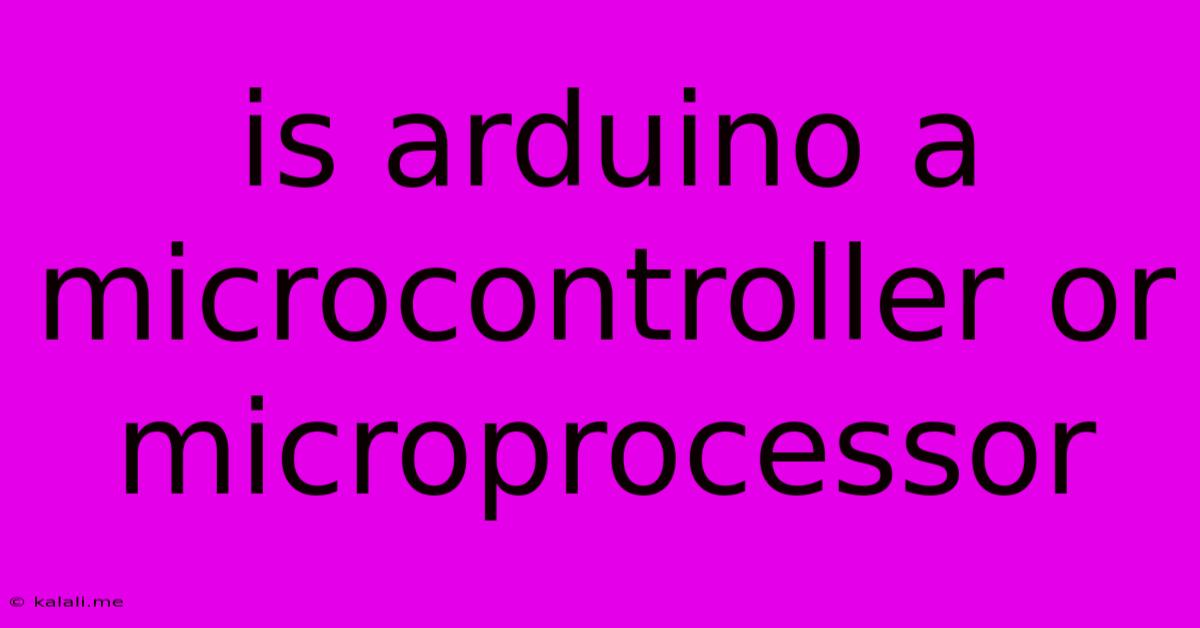Is Arduino A Microcontroller Or Microprocessor
Kalali
Jun 06, 2025 · 3 min read

Table of Contents
Is Arduino a Microcontroller or a Microprocessor? Understanding the Difference
The terms "microcontroller" and "microprocessor" are often used interchangeably, leading to confusion, especially for beginners in electronics and programming. This article clarifies the distinction and definitively answers the question: Is Arduino a microcontroller or a microprocessor? The short answer is: Arduino is a microcontroller. But understanding why requires exploring the core differences between these two essential components of embedded systems.
Many aspiring makers and programmers often stumble upon this question while starting their journey into the world of electronics and embedded systems. This article aims to provide a clear and concise explanation to settle the confusion once and for all.
Microprocessors: The Brains of a Computer
A microprocessor is essentially the central processing unit (CPU) of a computer system. It's responsible for executing instructions from software, performing calculations, and managing data flow. Think of it as the brain of your desktop computer, laptop, or smartphone. Key characteristics include:
- Complex Instruction Set: Microprocessors typically have a complex instruction set architecture (CISC), allowing for a wide range of instructions.
- High Processing Power: They offer significantly higher processing power compared to microcontrollers.
- External Memory and Peripherals: Microprocessors require external memory (RAM and ROM) and peripheral devices (like keyboards, mice, and displays) to function. They don't usually have these built-in.
Microcontrollers: Tiny Computers on a Chip
A microcontroller is a single integrated circuit (IC) that contains a CPU, memory (RAM and ROM), and input/output (I/O) peripherals all on one chip. This makes them self-contained and ideal for embedded systems applications. Key differences from microprocessors include:
- Reduced Instruction Set: Microcontrollers often use a reduced instruction set computer (RISC) architecture, simplifying the instructions and making them faster and more energy-efficient.
- Lower Processing Power: They typically have lower processing power than microprocessors, sufficient for their targeted applications.
- Integrated Peripherals: A key feature is the integration of peripherals directly onto the chip, including analog-to-digital converters (ADCs), timers, and serial communication interfaces.
Arduino: A Popular Microcontroller Platform
The Arduino platform, built around various microcontroller chips (often AVR microcontrollers from Atmel, now Microchip), is a microcontroller-based platform. The Arduino IDE, libraries, and community support make it accessible and beginner-friendly for building diverse projects.
The Arduino Uno, for instance, utilizes an ATmega328P microcontroller. This chip includes everything needed for a wide range of embedded applications – all integrated onto a single chip: processing unit, memory, and I/O capabilities. This confirms that Arduino, at its core, is a microcontroller platform.
Key Differences Summarized:
| Feature | Microprocessor | Microcontroller |
|---|---|---|
| CPU | Separate component | Integrated on the chip |
| Memory | Requires external RAM and ROM | Integrated RAM and ROM on the chip |
| Peripherals | Requires external peripherals | Integrated peripherals on the chip |
| Instruction Set | Complex Instruction Set (CISC) | Reduced Instruction Set (RISC) |
| Processing Power | High | Low |
| Applications | General-purpose computing | Embedded systems, IoT devices, robotics |
In conclusion, while both microprocessors and microcontrollers are vital components in various technological applications, the Arduino platform relies on the functionality of a microcontroller. Its integrated nature and simplified programming environment make it an excellent choice for hobbyists, students, and professionals alike working on embedded systems projects. Understanding this distinction is crucial for anyone venturing into the fascinating world of embedded systems programming.
Latest Posts
Latest Posts
-
Cleaning Out Fridge After Power Outage
Jun 07, 2025
-
How To Move A Washer And Dryer
Jun 07, 2025
-
How Do You Make Equipment Not Break Minecraft
Jun 07, 2025
-
Can You Paint In The Cold
Jun 07, 2025
-
King James Bible Vs Catholic Bible
Jun 07, 2025
Related Post
Thank you for visiting our website which covers about Is Arduino A Microcontroller Or Microprocessor . We hope the information provided has been useful to you. Feel free to contact us if you have any questions or need further assistance. See you next time and don't miss to bookmark.